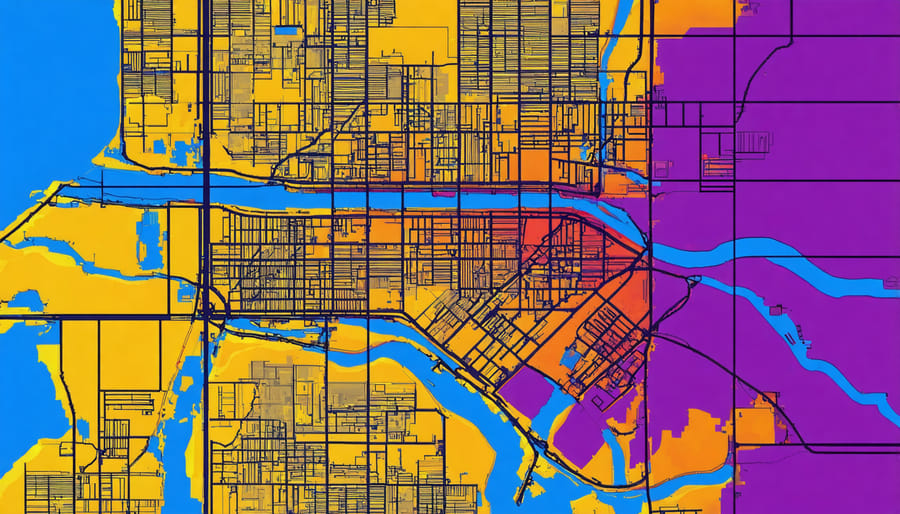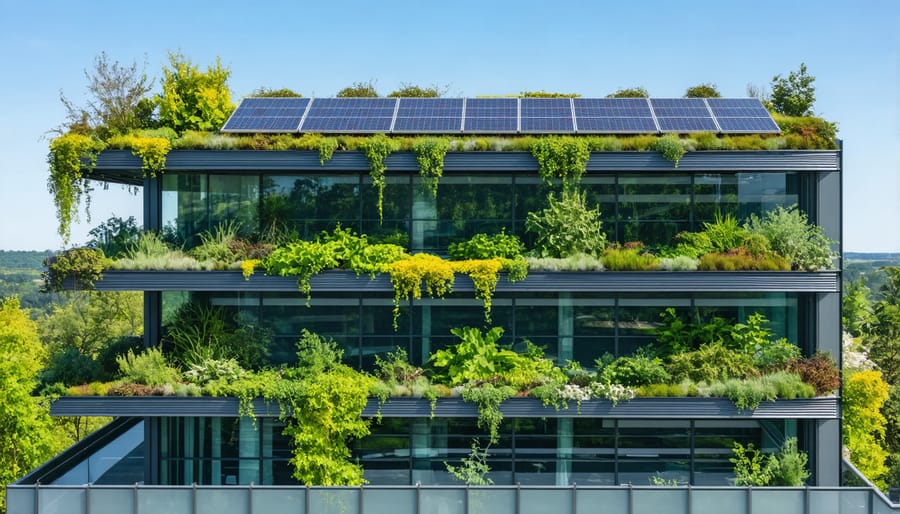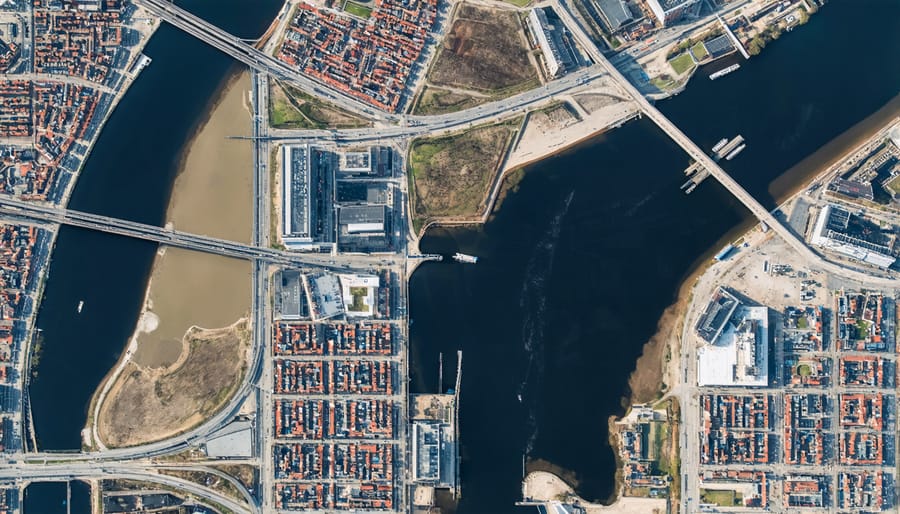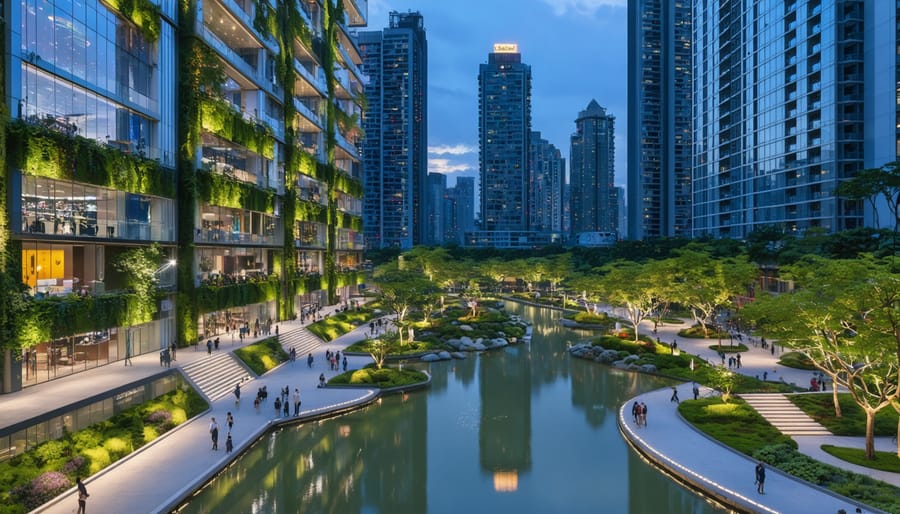Urban planners face an unprecedented challenge as climate change reshapes the fundamental principles of city development. The integration of climate-resilient infrastructure has become not just an environmental imperative but a critical economic necessity. Recent data from the World Bank indicates that climate-adaptive urban planning can reduce disaster-related losses by up to 30% while generating $4 in benefits for every $1 invested.
Modern urban development demands a threefold approach: implementing heat-resistant materials and designs to combat rising temperatures, incorporating green infrastructure to manage intensifying precipitation patterns, and developing flexible land-use policies that anticipate climate-driven population shifts. Cities like Copenhagen, Rotterdam, and Singapore demonstrate how integrated climate adaptation strategies can transform vulnerable urban areas into resilient, sustainable communities.
This technical analysis explores cutting-edge approaches to climate-adaptive urban planning, examining both immediate interventions and long-term strategic frameworks. From advanced stormwater management systems to innovative building codes that anticipate future climate scenarios, we’ll investigate how construction professionals can effectively implement these crucial adaptations while maintaining project viability and regulatory compliance.
The Climate Crisis in Urban Environments
Urban Heat Islands
Urban Heat Islands (UHI) represent one of the most significant challenges in modern urban environments, where cities experience temperatures up to 7°C higher than surrounding rural areas. This phenomenon occurs due to the concentration of heat-absorbing materials like concrete, asphalt, and steel, combined with reduced vegetation and increased human activity.
Recent studies by the Environmental Protection Agency indicate that dark surfaces in urban areas can reach temperatures of 50-90°F hotter than the air, while standard dark roofs can be up to 40-50°F warmer than ambient air temperatures. These elevated temperatures not only impact human comfort and health but also significantly increase energy consumption for cooling systems and accelerate the deterioration of building materials.
The intensification of the UHI effect is particularly evident in dense urban cores, where building configuration and street canyons trap heat and restrict air circulation. According to research conducted by the American Society of Civil Engineers, cities with populations over 1 million typically experience annual mean air temperature increases of 1.8–5.4°F compared to their rural surroundings.
To combat this effect, construction professionals are implementing various mitigation strategies, including:
– Installing cool roofs with high solar reflectance
– Incorporating green infrastructure and urban forestry
– Utilizing permeable pavements
– Designing for enhanced natural ventilation
– Implementing strategic building orientation
These solutions have demonstrated temperature reductions of 2-4°F in pilot projects across major metropolitan areas, proving their effectiveness in urban heat management.

Flooding and Stormwater Management
Rising precipitation levels and extreme weather events pose significant challenges for urban infrastructure, necessitating innovative approaches to stormwater management systems. Cities must adapt their infrastructure to handle increased rainfall intensity while protecting buildings, transportation networks, and public spaces from flood damage.
Key strategies include implementing permeable pavements, bioswales, and retention basins that allow natural water infiltration and reduce surface runoff. Green infrastructure solutions, such as rain gardens and constructed wetlands, serve dual purposes by managing stormwater and enhancing urban biodiversity.
Recent developments in smart water management technology enable real-time monitoring and adaptive response to precipitation events. Sensors and automated systems can regulate water flow, prevent system overload, and direct excess water to designated storage areas. These technologies, combined with predictive modeling, help cities anticipate and respond to flood risks more effectively.
Case studies from cities like Copenhagen and Rotterdam demonstrate the success of integrated flood management approaches. Copenhagen’s Cloudburst Management Plan, for instance, combines underground storage tunnels with surface-level solutions like water squares and green corridors, effectively managing extreme rainfall while creating valuable public spaces.
To ensure long-term resilience, urban planners must consider future climate projections when designing drainage infrastructure and incorporate redundancy in flood defense systems. This approach requires close collaboration between engineers, architects, and municipal authorities to develop comprehensive solutions that protect urban assets while promoting sustainable water management practices.
Innovative Design Solutions for Climate Resilience
Green Infrastructure Integration
The integration of green infrastructure solutions has emerged as a critical component in climate-resilient urban planning. These natural systems provide multiple benefits, including temperature regulation, stormwater management, and carbon sequestration, while enhancing urban biodiversity and improving public health outcomes.
Green roofs represent a particularly effective intervention, capable of reducing building energy consumption by 15-45% through improved insulation and reduced heat island effect. Advanced extensive green roof systems, incorporating drought-resistant vegetation and smart irrigation, can retain up to 75% of rainfall, significantly reducing stormwater runoff in dense urban environments.
Urban forests and strategic tree placement play an equally vital role. Studies indicate that mature urban trees can reduce local ambient temperatures by 2-8°C through evapotranspiration and shading. When properly integrated into street design, they can also decrease stormwater runoff by up to 62% while sequestering significant amounts of carbon dioxide.
Recent innovations in bioswale design and permeable pavement systems have enhanced the effectiveness of these natural solutions. Contemporary bioswales incorporate engineered soils and native plant species, achieving filtration rates of up to 90% for common urban pollutants. These systems can be seamlessly integrated into existing infrastructure, providing both functional and aesthetic benefits.
Implementation success depends on careful consideration of local climate conditions, soil characteristics, and maintenance requirements. Project managers should conduct thorough site analyses and consult with landscape architects to develop appropriate plant selection strategies and maintenance protocols. Regular monitoring of system performance and adaptation of management practices ensures long-term sustainability and effectiveness.
Cost-benefit analyses consistently demonstrate the economic viability of green infrastructure investments, with returns typically realized within 5-7 years through reduced energy costs, enhanced property values, and decreased stormwater management expenses. Moreover, these solutions often prove more resilient to climate extremes than traditional gray infrastructure alternatives.

Smart Building Technologies
In response to escalating climate challenges, smart building technologies have emerged as crucial components in climate-resilient urban development. These adaptive systems integrate sophisticated sensors, automated controls, and artificial intelligence to optimize energy consumption while maintaining occupant comfort.
Building automation systems (BAS) form the backbone of these innovations, continuously monitoring and adjusting HVAC operations, lighting levels, and power distribution based on real-time occupancy patterns and environmental conditions. Advanced analytics platforms process this data to identify efficiency opportunities and predict maintenance needs, resulting in energy savings of up to 30% compared to conventional buildings.
Envelope technologies have also evolved significantly, incorporating dynamic façade systems that automatically adjust to external conditions. These include electrochromic glazing that modifies its tint based on solar radiation levels and advanced insulation materials that adapt their thermal properties to maintain optimal indoor temperatures.
Energy management systems integrate on-site renewable energy generation with storage solutions, enabling buildings to participate in demand response programs and reduce grid dependency during peak periods. Machine learning algorithms optimize these systems by predicting energy demand patterns and adjusting consumption accordingly.
Water conservation technologies play an equally important role, with smart meters detecting leaks and monitoring usage patterns. Greywater recycling systems, coupled with rainwater harvesting, significantly reduce potable water consumption while supporting building cooling through green roof systems.
The implementation of these technologies requires careful consideration of initial costs versus long-term benefits. Recent case studies demonstrate ROI periods of 3-5 years for comprehensive smart building upgrades, with additional benefits including improved occupant satisfaction and reduced maintenance costs. As climate change intensifies, these systems become increasingly vital for creating resilient urban environments that can adapt to changing environmental conditions while minimizing their carbon footprint.
Case Study: Rotterdam’s Climate Adaptation Strategy
Rotterdam, a city largely situated below sea level, has emerged as a global leader in climate-adaptive urban planning, implementing innovative solutions that serve as a blueprint for coastal cities worldwide. The city’s comprehensive Climate Adaptation Strategy, launched in 2013 and continuously evolved, demonstrates how metropolitan areas can transform climate challenges into opportunities for sustainable development.
At the heart of Rotterdam’s strategy lies its water management system, which includes multifunctional water squares that serve as recreational spaces during dry weather and transform into water retention basins during heavy rainfall. The Benthemplein Water Square, completed in 2013, can store up to 1.7 million liters of water, significantly reducing flood risks in surrounding neighborhoods while providing valuable public space.
The city has also pioneered the concept of “climate-proof buildings,” with developments like the Floating Pavilion in the Rijnhaven demonstrating how architecture can adapt to changing water levels. This approach has been expanded to include entire floating communities, showing how urban development can work with water rather than against it.
Green infrastructure plays a crucial role in Rotterdam’s strategy. The city has implemented over 236,000 square meters of green roofs, which not only manage stormwater but also reduce urban heat island effects and enhance biodiversity. The Dakpark, Europe’s largest green roof park, exemplifies this approach by combining flood protection with public recreation space and commercial development.
Rotterdam’s success can be attributed to several key factors:
– Integration of climate adaptation into all urban planning decisions
– Strong public-private partnerships driving innovation
– Community engagement in project design and implementation
– Flexible and adaptive management approaches
– Continuous monitoring and evaluation of implemented measures
The economic benefits have been substantial, with the strategy attracting international investment and creating new jobs in the environmental sector. The city reports a 20% reduction in flood-related incidents since implementation began, while property values in adapted areas have increased by an average of 15%.
Rotterdam’s experience demonstrates that successful climate adaptation requires long-term vision, political commitment, and technical innovation. The city continues to evolve its strategy, recently focusing on heat stress reduction and expanding its network of climate-adaptive infrastructure, setting new standards for urban resilience in the face of climate change.

Implementation Strategies and Challenges
Policy Framework and Regulations
Effective climate change urban planning requires a robust policy framework supported by comprehensive regulations at multiple governmental levels. Local authorities must align their building codes and zoning regulations with national climate adaptation goals while implementing urban resilience strategies that address specific regional challenges.
Key regulatory components typically include mandatory green building standards, energy efficiency requirements, and climate risk assessment protocols for new developments. Cities leading in climate-adaptive planning have introduced performance-based zoning that rewards developers for incorporating sustainable design elements and climate mitigation features.
Financial mechanisms, such as climate bonds and green infrastructure funds, must be supported by clear regulatory frameworks that define eligible projects and establish monitoring protocols. Many jurisdictions have implemented carbon pricing policies and emissions trading schemes to incentivize low-carbon development practices.
Successful policy frameworks often incorporate:
– Mandatory climate risk assessments for major developments
– Updated flood zone regulations reflecting climate projections
– Requirements for green infrastructure in new developments
– Incentive programs for retrofitting existing buildings
– Streamlined approval processes for climate-adaptive projects
Progressive cities are also introducing climate overlay zones that impose additional requirements in vulnerable areas, while offering density bonuses and expedited permitting for projects that exceed minimum climate resilience standards. These regulatory tools must be regularly updated to reflect emerging climate science and technological advances, ensuring continued effectiveness in addressing evolving environmental challenges.
Cost Considerations and ROI
Implementing climate-responsive urban planning strategies requires significant upfront investment, but the long-term financial benefits often outweigh initial costs. According to recent industry analyses, climate-adapted infrastructure projects typically demonstrate ROI within 7-15 years through reduced maintenance costs, improved energy efficiency, and enhanced resilience to extreme weather events.
Key cost considerations include infrastructure modifications, green technology implementation, and professional services for planning and design. Studies indicate that incorporating climate adaptation measures during initial planning stages adds approximately 2-5% to overall project costs, while retrofitting existing infrastructure can increase expenses by 15-30%.
However, the financial benefits are substantial. Cities implementing comprehensive climate adaptation strategies report:
– 20-40% reduction in energy costs through efficient building design
– 30-50% decrease in storm damage repair expenses
– 15-25% lower insurance premiums for climate-resilient structures
– Increased property values of 5-10% in areas with green infrastructure
The World Bank estimates that every $1 invested in climate-resilient infrastructure generates $4 in benefits. This includes direct savings from reduced disaster recovery costs and indirect benefits such as improved public health outcomes and enhanced economic activity.
Case studies from major urban centers demonstrate that green infrastructure solutions, such as bioswales and permeable pavements, often cost 25-30% less to maintain than traditional gray infrastructure over their lifecycle. Additionally, municipalities can leverage various funding mechanisms, including green bonds, public-private partnerships, and government grants, to offset initial implementation costs.
To maximize ROI, experts recommend phased implementation approaches, prioritizing high-risk areas and integrating climate considerations into existing infrastructure renewal schedules.

Climate change urban planning has emerged as a critical cornerstone in building resilient, sustainable cities for future generations. The integration of climate adaptation strategies into urban development frameworks represents both a challenge and an opportunity for construction professionals and city planners. Through the implementation of green infrastructure, smart building technologies, and adaptive design principles, cities can significantly reduce their carbon footprint while enhancing resilience to climate-related risks.
The success of climate-responsive urban planning relies heavily on collaborative efforts between architects, engineers, policymakers, and community stakeholders. As demonstrated by pioneering projects worldwide, effective solutions often combine traditional construction wisdom with innovative technologies and materials. The future outlook for climate-adaptive urban planning remains promising, with emerging technologies and sustainable practices continuing to evolve.
Moving forward, the construction industry must prioritize climate considerations in every aspect of urban development. This includes embracing renewable energy systems, implementing water-sensitive design, and adopting circular economy principles in construction practices. The path ahead requires ongoing investment in research, development of new construction methodologies, and commitment to sustainable urban growth that balances environmental protection with economic development.

